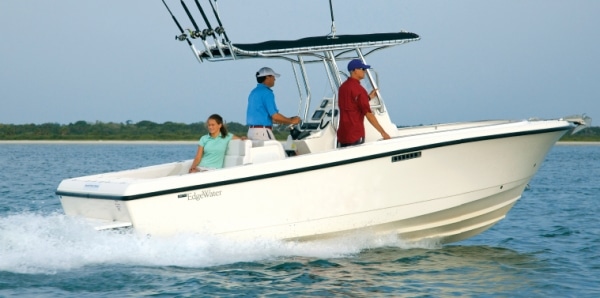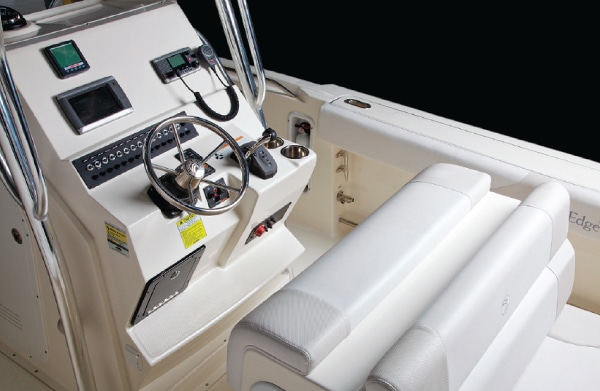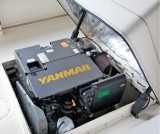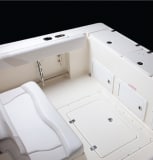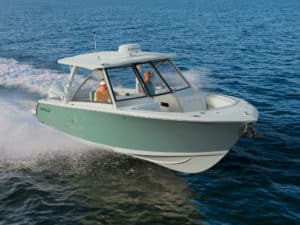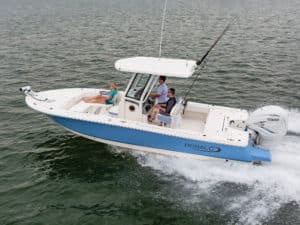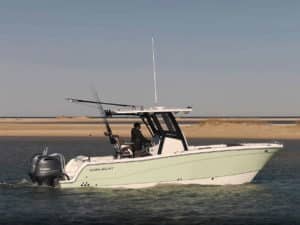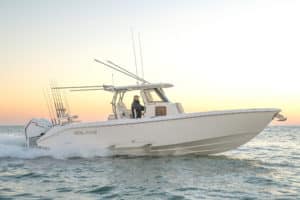The Peregrine Fishing Lodge in British Columbia contacted EdgeWater Boats with a unique request. The lodge needed heavy-duty center‑consoles that could handle the rough waters of the region’s salmon fishery, but with the power plant located amidships to keep the weight forward and create more cockpit space.
EdgeWater modified its venerable 228 CC and delivered to Peregrine a boat with a gasoline inboard jack-shafted to a sterndrive. Then, EdgeWater president Peter Truslow and his crew thought, “Why not a small diesel?” The result is the new 228 CCD, a center-console that surprises with its maneuverability and efficiency.
Performance
The 228 CCD is powered by a Yanmar 4BY2-180z, which is actually a marinized inline-4 BMW engine. Paired with Yanmar’s ZT370 sterndrive, the little diesel makes the boat do interesting things. Hitting the throttles, I experienced a slight delay as the diesel “wound” up, but I felt absolutely no squat as the boat planed.
The boat holds plane at 2,500 rpm and around 15 mph, where it burns a paltry 4 gallons per hour (equal to about 3.7 mpg). Its sweet spot is around 3,500 rpm, where it hits 27.4 mph and burns 6.3 gph, which translates into roughly 4.4 mpg.
But the beauty of a diesel is you can run one just a hair off wide-open throttle for extended periods without damaging the engine; with three aboard and full fuel, we topped out at 35 mph (4,100 rpm), getting just under 4 mpg. That’s about a mile per gallon better than what the 228 CC burns at 35 mph with an F250 outboard (according to Yamaha performance bulletins).
Handling is where the 228 CCD really shined. Moving the engine amidships altered the boat’s center of gravity, but EdgeWater made no alterations to the running surface. In fact, when Marine Concepts performed hydrostatic tests, it predicted that moving the engine forward would make the boat perform better. The company was right.
The 228 has a level running attitude, and handles wakes and chop with grace. Turning the wheel hard over at 30 mph, I carved tight, arcing turns with no fear of prop blowout — a feat not possible with outboard power.
Fishing
All that performance sounds nice, but another reason Peregrine wanted to move the power forward was to free up fishing space in the cockpit. By moving the console forward and housing the engine under the leaning post, EdgeWater created an extra 10 inches of cockpit length. Ditching the outboard motorwell for a straight transom added an additional 8 inches.
The straight transom also aids in keeping water out when backing down on a fish, giving the 228 CCD more of a big-game feel in that department. The stainless-steel toe rails running along either side of the cockpit allow an angler to dig in for the fight.
Another performance aspect that counts for offshore anglers — this boat gets exceptional fuel-burn numbers at trolling speeds, around 12 mpg at 6.5 mph. That translates to a long time with lines in the water.
The transom features a 28-gallon livewell and a tackle-storage system. There are four rod holders in the gunwale topsides, as well as rod racks recessed under the gunwales, which hold three rods per side. Add in the four holders on the T-top, and there’s plenty of room to pack your arsenal.
EdgeWater had to shrink the forward fish box to accommodate the diesel package, but the 34-gallon insulated box still holds a decent catch.
Design and Construction
EdgeWater prides itself on building “unsinkable” boats, an attribute that starts with the Single Piece Infusion process. The 228 is built with vacuum infusion, using high-quality vinylester resin. SPI allows EdgeWater to use 50 percent less resin, making the hull much lighter. The stringers, hull and engine bed are infused at the same time. Composite coring in the stringers further keeps the weight down; closed‑cell foam makes it buoyant.
As mentioned, EdgeWater moved the console to fit the diesel. The second major modification involved installing a smaller fuel tank — 72 gallons compared with a 125-gallon tank for the outboard version. Even with that lower fuel capacity, the two versions have roughly the same range thanks to the diesel’s inherent efficiency.
The engine hatch lifts on hydraulic rams, revealing the little BMW diesel that makes this boat a special catch, particularly for hard-core salmon guides or anyone else willing to try compression over combustion.
SPECIFICATIONS
LOA: 22 ft. 6 in.
BEAM: 8 ft. 6 in.
DRAFT: 21 in.
DEADRISE: 20 deg.
WEIGHT: 4,400 lb. (w/power)
FUEL: 72 gal.
MAX POWER: 180 mhp Yanmar Volvo Penta diesel sterndrive
YANMAR DIESEL/4BY2-180Z **
**TYPE: In-Line 4
DISPLACEMENT: 122 cid
MAX RPM: 4,000
HP/LB RATIO: 0.32
FUEL SYSTEM: aspiration, wate-gated, turbocharged
GEAR RATIO: 2.18:1
WEIGHT: 569 lb.
ALTERNATOR OUTPUT: 150 amps
MSRP AS TESTED: $91,528
EdgeWater Boats Edgewater, Florida 386-427-9783
ewboats.com
